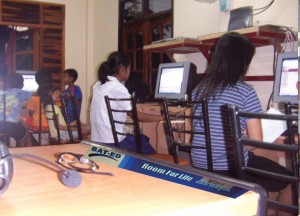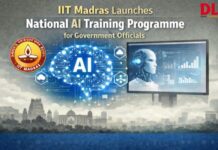 With a passion to bring better education to remote areas in Thailand, Sat-Ed System Co is delivering learning centres in rural Thailand called ‘Room for life’ using the cutting-edge technology of the iPSTAR broadband satellite. Aimed at providing lifelong learning for the rural Thai people, this initiative is providing access to education content in remote rural areas beyond the reach of telephone networks.
With a passion to bring better education to remote areas in Thailand, Sat-Ed System Co is delivering learning centres in rural Thailand called ‘Room for life’ using the cutting-edge technology of the iPSTAR broadband satellite. Aimed at providing lifelong learning for the rural Thai people, this initiative is providing access to education content in remote rural areas beyond the reach of telephone networks.
Chang is a bright young man who won a full scholarship to a technical university in Thailand. He had to turn it down because, while it would pay for his tuition and fees he had no way to support himself living in Bangkok and his parents were not well enough off to pay for it either. Chang was overjoyed when he learned about the Sat-Ed Room for Life because it will allow him the chance to earn his degree without leaving the village. There are many kids just like Chang; kids who are bright and eager and desperate to learn but time, money and other circumstances keep them in he village. With the Room for Life, Chang and others will not have to make the hard choice because they can study there.
In the sleepy hamlet of Baan Nong Pai, deep in the rural heart of Sakhon Nakorn stands the pilot Room for Life, a unique educational and learning center. For the first time anywhere in the world, a village that has no phone lines has been able to access broadband Internet, IPTV VoD (providing educational video on
demand), web cam, university degrees and a whole host of vocational learning and e-government services. The development of IPTV (Internet Protocol elevision) over the last 3 years has dramatically changed the way pay TV will e seen in the future; and yet these technologies to date have not been used by he educational market even though they offer an unparalleled opportunity for learning as well as access to digital content.
The technology: InternetProtocol Television (IPTV)
First one has to understand the core technology. IPTV differs from normal TV-based delivery systems in that instead of being a passive device that you atch it is now a two-way interactive device. IPTV allows a person to interact ith the content delivered to the TV. To the viewer, it looks exactly like a ormal V screen as the pages are designed for viewing on a TV. Using a simple emote ontrol, a person can navigate through a series of high-quality videos and text pages, take tests using the remote control to answer the on-screen questions and be assessed on their results. In actual fact, these are computer web pages are being delivered through a thin web browser located in the IPTV
set-top box. Using middleware written for this purpose by Sat-Ed it becomes an interactive navigation device. This allows the TV to be used as the device to deliver a traditional LMS (Learning Management System) directly to the end-user’s TV instead of a PC. The thin web browser then takes an HTML or Java page and displays it on a TV screen.
Room for life- delivering education
In the village, the Room for Life has a great many different courses on offer. In addition to High School and University courses, there is a heavy emphasis on vocational training from agricultural practices to silk weaving and everything in-between. This often means that the students are older adults who have never seen a PC much less used one for learning. This is where the PC is a barrier to
learning. In the same way that our parents and grandparents would leave the VCR clock flashing 12:00 while waiting for a grandchild to come over and program it, older adults not trained on PCs look at it as an confronting technology. Contrast that to our experience with children in the Room for Life. In order to be delivered through IPTV, the video has to be converted into an Mpeg 2 transport stream. We were running out of time to make a deadline for
another Room for Life and, in desperation our chief engineer trained two of the village children, ages 11 and 14, to convert the videos to transport streams. To our engineer’s shock and surprise, the children listened carefully and fearlessly
started to convert video files flawlessly. When seasoned pay-TV pros heard about this they were mightily impressed. We have found that the children under 15 in the village are soon learning things on the computer that took other people years to figure out for themselves. The adults are a different story.
Perhaps the most telling story about the differences between the two groups was illustrated by the time I handed my laptop with one hand to one of the adults to hold while I did something else. Their eyes got wide and they backed away, unwilling to take on that kind of responsibility for fear of breaking it. Their child popped up and took it from me without hesitation as the parent barked out warnings to the child to be careful. I was intrigued and tried this over and over with different adults over the course of several weeks and the result was the same. All of them either backed away or grabbed it with both
hands, visibly scared of breaking it. In contrast the children all took it without thinking at all. That is where using IPTV as an educational tool becomes so
important. It allows these adults to access content, often in a group, using the same technology that they se sitting in front of their TV at home… a remote control. With this remote control, they can navigate through a course; stop, fast-forward, rewind or pause to discuss what they have just learned. They can stop a course for the evening and go back and pick it up where they last left off.
Coming soon will be the ability for the student to input their ID number into the system and the middleware will know where they left off so there is no time-consuming backtracking to find the spot. The Sat-Ed LMS will then track their progress and report back nightly by satellite. Another important part of the technology is the use of “Push” technology. Through the use of a next-generation of satellite such as iPSTAR, content is “pushed forward” so it resides on the Sat-Ed digital library. This specially designed VOD server caches the educational content at each site so when a student accesses it using the IPTV STB it plays out the transport stream instantly, in fullscreen, media-rich
video. This greatly enhances the educational experience. The trouble with Internetbased e learning is that your experience is connection dependent. ven with broadband access (a rarity inside Bangkok and unheard in the rural reas) the most you will be able to view is a postagestamp- sized video because the content is created for the lowest common denominator. You also have to wait for the information to come through the Internet pipeline and the content delivery is as slow as the slowest pipe it has to go through to get to the user. This often creates a scenario where, even with a broadband connection, a person is always waiting for the buffering to finish; turning the World Wide Web
into the World Wide Wait. Contrast that to VOD learning with the content residing in the Sat-Ed digital library on-site. It plays out an instantaneous stream in full-screen color. This allows extensive use of video in training and it also gives the students additional video cues for enhanced learning. Studies have shown that people learn in different ways. By delivering as many cues as
possible to learning, you increase dramatically the chances that one of them will be ultimately successful for the viewer. This mirrors the old adage of not just telling someone what to do but also show them what to do. With IPTV-based learning, the video that is elivered can address both of these at once. That brings us to an interesting problem. There are a number of training courses available but there is a paucity of content for IPTV-based learning. nly a few forward-thinking organizations have developed content so far but as the emand rows, the availability will increase dramatically. Already curriculum is being written that ddresses the ability to use IPTV as a teaching tool as an adjunct to traditional face-to-face teaching models. Potential uses for this might be a history class that watches a video of news reports of the period
just studied. Another might be a chemistry class watching a video presentation of a chemical interaction shown in a lab setting instead of just reading about it. Still another might be an anatomy class watching a video of a dissection of a rat while following along with their own specimen to dissect in the classroom.
The first use of the Sat-Ed Digital Library is the caching of educational content for on-demand access. A second use, almost as important in an educational setting, is the caching of web sites. Because education is predicative, we can
assume that there are a number of sites that students will want to access. In a
school settings using the Sat-Ed digital library, the web pages are updated nightly by satellite and stored on the server. When the students go to access it in the classrooms all over the country linked into Sat-Ed digital libraries, instead of having to wait while each person is trying to access the same file over and over, they get it instantly. By multicasting it once to all the sites that are linked to the Sat- Ed network, it saves dramatically on bandwidth costs and greatly reduces the burden on the in-school network.
Room for life- beyond education
There are other uses for the Room for Life in addition to strictly educational uses. Patra had not seen her children since April last year, nearly a year ago.
Patra is not a bad mother. The economic reality of her small village in the Northeast of Thailand means she has to leave to find work in the Deep South in a rubber plantation. On Saturday, she got to see them and talk to them for an hour. It cost her 20 baht (50 US cents). Patra went to an Internet café near
where she works in the South and their grandmother brought the children to the newly opened Sat-Ed “Room for Life”. There her children, Beau and Bee, were able to talk to their mother online using a web cam and VoIP available in the Room for Life. The hour cost the grandmother 20 baht. Many of the illagers have family that are away temporarily in places all over the globe and the
ability to stayed in touch with them through VoIP is priceless. Also there is the opportunity to bring the market to the village. By using Ebay and other sites to sell their goods, villagers can cut out the middleman who marks up the fruits of
their labor and makes a profit simply because the villagers do not have access to the marketplace. With the Sat-Ed Room for Life the global village becomes a reality. Each Room for Life site will be owned by a local IT professional who invests in the franchise. All of the profits generated stay in the community and
there is someone who is able to address the unique needs of each site. Sat-Ed does its part by continually aggregating content and responding to requests from the field. Currently, Thailand has an Internet access penetration of only 11.9%. This number is skewed on the high side with a 29% access rate in
Bangkok. The rural areas are much lower. By using IPTV through the Room for Life Sat-Ed has built a bridge across the digital divide and helped to provide access to education to everyone. The ability for everyone to access knowledge is available through this technology today. With the technology in place in the village, the only limits one has are the limits to their own imagination.?
























